You’ve got an idea for a Proof of Concept (PoC), and you know it can be a game changer for your company. But here’s the thing: if you can’t convince the powers that be—your stakeholders or the C-suite—you’re not getting the funding. You need a PoC Proposal!
Building a strong business case for a Proof of Concept (PoC) shows stakeholders that investing in a PoC is a strategic move, one that reduces risks, optimizes resources, and aligns with business goals.
For executives and decision-makers, committing to a PoC can be challenging without a clear picture of its benefits.
I’ve seen good ideas die in boardrooms because the pitch was all over the place. I’m Martin Naughton, Managing Director at Galvia Digital, and today I’m going to walk you through how to put together a PoC proposal that gets a “yes.”
This guide breaks down how to justify PoC investments, perform cost-benefit analyses, and communicate value effectively to secure executive buy-in.
For a broader overview of PoCs and their role in software development, see our main article, What is Proof of Concept in Software Development and Why Your Business Needs It.
Why Your PoC Proposal Needs to Be Spot-On
A solid PoC proposal is your ticket to securing that crucial investment. If it’s vague or full of holes, decision-makers will see your project as a risk they don’t want to take.
Now, you’ve probably heard about creating a “business case” for your PoC, and it’s worth knowing how these two differ yet work together.
A PoC proposal is your initial pitch, laying out your Proof of Concept’s goals, approach, and what you need to get started. The business case, however, dives deeper into the strategic and financial justification, showing the full long-term impact.
They complement each other—your proposal gets the conversation going, and the business case locks in the commitment.
In this article, I’ll guide you through the proposal side to help you get that first green light.
A well-thought-out business case for PoC gives stakeholders the confidence they need to see the potential value and reduced risks of your project.
Without a strong PoC proposal and business case, your idea may just look like an unnecessary expense. But when presented right, a PoC transforms into a powerful tool that safeguards larger investments by testing feasibility upfront. Decision-makers are far more likely to approve your project when they grasp the strategic benefits.
How Does a PoC Align with Business Goals?
A PoC aligns with business goals by focusing on strategic areas such as risk management, cost efficiency, or digital transformation.
When building a case for a PoC, link its objectives directly to the company’s strategy. For instance, if the company’s goal is to stay ahead in digital innovation, explain how the PoC will test cutting-edge technology or new product features that support that objective. By aligning the PoC with larger goals, you show stakeholders it’s not just a “test run” but a step toward meaningful progress.
What Steps Are Needed to Build a Strong Proposal / Business Case for a PoC?
Building a compelling business case for a PoC involves setting clear goals, outlining benefits, and showing how the PoC will mitigate risks and create value.
Key Steps to Building a Business Case
Define the PoC’s Goals and Strategic Alignment
Start by defining what the PoC aims to achieve and link it to business priorities. Whether testing new technology or validating a product, this alignment assures stakeholders the PoC supports the company’s bigger objectives.Outline Expected Outcomes and Success Metrics
Identify what a successful PoC looks like, with specific metrics for measuring success. This could involve technical feasibility, customer demand, or compatibility with existing systems.Address Risks and How the PoC Mitigates Them
Explain how the PoC will address potential project risks. For example, if a project involves new technology, a PoC can test its stability, catching potential issues early.Perform a Cost-Benefit Analysis
A cost-benefit analysis shows that the PoC is a wise investment. For example, a successful PoC could reduce development costs by up to 30% by identifying issues early.Describe the Strategic PoC Deployment Plan
Provide a realistic plan for executing the PoC, including timelines, team roles, and resources. This helps assure executives that the PoC is both achievable and valuable.
How to Justify PoC Funding with a Cost-Benefit Analysis?
This is where your PoC proposal needs to shine. A strong cost-benefit analysis makes it clear why a PoC is worth the investment, highlighting potential savings and risk reduction. Show them it’s a smart move in your PoC proposal!
Cost Considerations
Lay out every expense. Team hours, software, third-party tools—list it all. If there are opportunity costs (like pausing another project), mention those too. No one likes surprises later.
- Direct Costs: Include costs related to team hours, software, or other tools needed for the PoC.
- Opportunity Costs: Factor in any impacts on other projects that might need to pause during the PoC.
Expected Benefits
Now, show them the upside. Will this PoC lead to faster time to market? Will it prevent costly rework? Put numbers on it. If you can say, “This PoC could save us £100,000 in a year,” you’re doing it right.
Risk Reduction: By catching issues early, a PoC prevents costly problems down the line.
Development Cost Savings: Projects with a successful PoC can save up to 30% in development costs by avoiding rework.
Market Readiness: A PoC can speed up time to market, reducing delays and keeping the business competitive.
Tackling Risk Head-On with Solid PoC Documentation
No one wants to fund a project that could go belly-up. That’s why you need airtight PoC documentation to show you’ve thought this through.
Identify Risks and Mitigate Them
Every project has risks. Maybe the tech could fail, or maybe it won’t integrate as smoothly as you’d like. Spell out these risks and how you plan to handle them. It shows you’re realistic and prepared.
Example: “We’ll run security checks and use encryption to handle data concerns. If there’s a technical issue, we have a backup plan to minimize downtime.”
By being upfront, you’re building trust. Simple as that.
Building a Business Case for a PoC That Actually Resonates
How to Communicate Your PoC Proposal Effectively
Fancy words and jargon won’t win you funding. People are busy. Make your point and make it fast. Effective communication is key to getting executive buy-in for a PoC, especially when stakeholders may be cautious about approving a new project. Here are some tips:
How to Communicate the Value of a PoC to Secure Buy-In?
If you’re serious about getting buy-in for a Proof of Concept (PoC), you need to focus on what matters most to decision-makers: risk, cost, and return.
Here’s how to cut through the noise and present a case that’s hard to argue with.
1. Highlight the Problem in Plain Terms
Don’t overcomplicate it. Executives want to know what the issue is and how it’s affecting the business. “Our current system leads to €300,000 in annual losses due to inefficiencies.” Put the pain points in numbers where possible. People pay attention to numbers, not vague statements.
2. Explain Why a PoC is the Smart First Step
A PoC isn’t about diving in headfirst. It’s about dipping a toe in the water to test viability. Frame it as a controlled, low-risk trial. Something like: “We’re looking at a modest €40,000 investment for a PoC to determine if this approach could save us upwards of €300,000 a year. If it fails, the loss is limited. If it works, we have a proven model to scale.”
Executives aren’t keen on risk, and this approach keeps things manageable.
3. Quantify the Potential Gains
Keep the projections realistic but impactful. Spell out what success would look like in financial terms: “A successful PoC could mean reducing error rates by 20%, leading to a €60,000 annual saving. Scale that, and you’re looking at substantial impact across the board.”
Don’t try to dazzle anyone. Just let the numbers speak for themselves.
4. Talk About the Path to Scale
Executives like to know there’s a plan beyond the trial. “If the PoC proves effective, the next steps involve rolling out across three additional departments, with potential annual savings scaling to €180,000.” Be practical. They want to see that the potential gains justify the initial spend.
Need a Framework to Get This Right?
We’ve put together a no-nonsense toolkit: “Building a Winning Proposal for Your Proof of Concept!”
It includes everything you need to make a rock-solid pitch, from a detailed eBook and customizable proposal template to a data collection worksheet, ROI calculator, and a professional pitch deck. No fluff, no gimmicks—just a clear, structured approach to help you get the green light from your executive team.


Download the PoC Proposal Toolkit Here!
Remember, executives don’t have time for showmanship or hype. Keep your case dry, data-driven, and grounded in practical next steps. That’s what earns their attention, front-loading the stuff that matters and, more importantly, gets their approval.
Extra Tips for Communicating PoC Value
Use Data and Real Examples (with simple visuals)
Present data that highlights the benefits of PoCs, such as how projects that start with a PoC reach market 40% faster than those that don’t. Graphs work wonders. A quick cost-benefit analysis or a risk-reduction chart can get your point across without a wall of text. Example: “Here’s how the PoC pays for itself in under a year,” followed by a simple bar graph.Highlight Strategic Alignment
Reinforce how the PoC aligns with business goals, whether it’s reducing risks, exploring new markets, or supporting innovation.Break Down the Costs and Savings
Use clear figures from the cost-benefit analysis to show the PoC’s value. For example, highlight how early validation through a PoC can prevent costly rework.Emphasize Risk Mitigation
Explain how the PoC reduces risks by identifying challenges early. This is particularly important for projects that involve new technologies or untested concepts.Tailor Your Pitch
If you’re talking to a CFO, focus on financials—ROI, cost savings, that sort of thing. If it’s the CTO, hit on technical feasibility. Customize your pitch for whoever’s in the room.
By presenting a PoC as a strategic investment, you make it easier for decision-makers to see the value in testing ideas on a small scale before committing fully.
How Does a PoC Align with Executive and Stakeholder Needs?
A PoC aligns with executive priorities by offering a safe, cost-effective way to test high-stakes ideas, minimizing risks, and supporting informed decision-making.
Executives prioritize projects that offer a clear ROI, strategic alignment, and risk management. By showing that a PoC addresses these needs, you’re better positioned to secure the buy-in needed for innovation. When decision-makers see that a PoC supports growth and aligns with the business, they’re more likely to approve it.
To understand how PoCs can also reduce project risk, consider reading our article, How Proof of Concept Reduces Risks and Drives Innovation.
Case Study: McFarland Consulting’s Proof of Concept (PoC) Success
Here’s an example of how a PoC helped one of our clients to help get the creative juices flowing for your proposal!
McFarland Consulting, a civil and structural engineering firm, aimed to improve structural health monitoring through enhanced data collection and analysis. To achieve this, they partnered with Galvia Digital to create an automated data logging solution. The project began with a Proof of Concept (PoC) to validate the approach and ensure smooth integration before full-scale implementation.
Key Achievements & Insights:
- Efficient Development: The PoC was executed within a two-week sprint, providing McFarland Consulting with a detailed roadmap for the project’s full rollout.
- Proactive Risk Management: The PoC phase allowed for early detection of integration challenges, enabling architectural refinements to ensure a seamless system transition.
- Building Stakeholder Trust: The demonstrated efficiency improvements from the PoC earned stakeholder approval for the full project, which promised to reduce operational costs by 25%.
Outcome: McFarland Consulting effectively validated their modernization strategy with the PoC, laying the groundwork for a risk-reduced, impactful software transformation backed by strong stakeholder support.
Why a PoC is Essential for Business Growth
A well-built business case for a PoC is key to gaining the buy-in needed to test new ideas safely and efficiently. By aligning with business goals, outlining clear benefits, and mitigating risks, a PoC enables informed decision-making and reduces the likelihood of costly mistakes.
For a complete understanding of PoCs in software development and their broader impact, check out our Proof of Concept in Software Development and Why Your Business Needs It page.
Final Thoughts: Nail Your PoC Proposal
Getting buy-in for a PoC isn’t easy, but it doesn’t have to be a nightmare. The key is a tight proposal and business case that’s all substance, no fluff.
At Galvia Digital, we’ve helped companies get their PoCs off the ground—whether it’s smart tech, custom software, or legacy modernization. If you need guidance, we’re here to make your idea a reality.
And hey, if you’re looking for tools to help you craft that perfect PoC proposal, download our PoC Proposal Toolkit for Executives. It’s loaded with templates and resources to make your job easier.
Good luck, and give me a shout if you need some guidance.
Martin Naughton


Remember to Download the PoC Proposal Toolkit Here!
FAQ: Building a Business Case for PoC
How do I secure PoC funding?
You secure PoC funding by making a rock-solid case for ROI and risk management. Show the financial benefits clearly and address concerns before they’re even raised.
What makes a PoC proposal stand out?
A PoC proposal stands out when it’s clear, focused, and hits on what decision-makers care about: goals, costs, risks, and benefits.
Why is PoC documentation important?
PoC documentation is critical because it spells out the who, what, and how of your project. It’s your safety net, your proof that you’ve done the homework.
Why is a business case for a PoC important?
A business case for a PoC demonstrates its value, helping stakeholders see it as a smart investment rather than an extra cost.
How can I align a PoC with business goals?
Link the PoC’s objectives to the company’s strategy, such as digital transformation or cost efficiency, to show it supports broader goals.
What are the key steps to build a business case for a PoC?
Define clear goals, outline expected outcomes, identify risk management strategies, perform a cost-benefit analysis, and present a realistic deployment plan.
How does a PoC reduce project risks?
A PoC allows teams to identify and address issues early, reducing the chance of costly problems later on.
How do I communicate the value of a PoC to executives?
Use data, link the PoC to strategic goals, and present a clear cost-benefit analysis to show how the PoC minimizes risk and optimizes resources.
With a strong business case, you’re better positioned to secure the support and resources needed to explore innovative ideas with confidence.




Social Profiles